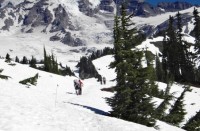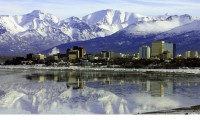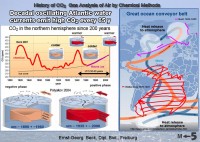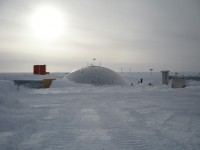
|
Jul 29, 2008
Snow Greets Visiting Hikers at Mount Rainier
By Howard Meyerson, Grand Rapids Press
Cool ocean temperatures in the southern Pacific Ocean—a phenomenon known as La Nina—chilled sunny expectations this summer for thousands of visitors to Mount Rainier National Park. Those who arrived here in July planning to backpack or hike its famous sub-alpine wildflower meadows found snow instead, six feet in places, though sunny daytime temperatures reach into the 70s.
The popular mountain that draws 1.5 million visitors each year received 950 inches of snow last winter, 300 inches more than its 650-inch average. Park officials said a cooler than usual spring also pushed back the thaw. “A lot of people were disappointed to come and find snowy meadows,” said Mike Punches, a park interpreter at the Henry M. Jackson Visitor Center at Paradise, located 5,400 feet above sea level. “Normally the wildflower season is all of July and August. The early bloomers come the first of July.

Press Photo/Howard Meyerson
Areas that feature the avalanche lily are limited to certain parts of the mountain."I led wildflower hikes in June on 10 feet of snow. They weren’t listed that way. We shifted them to ecology hikes about life on Rainier, and what it takes to adapt here.” Climate officials said the Pacific Northwest snowpack is the heaviest it has been since 1999. That’s when the last La Nina event occurred. Deep snows remain throughout the region affecting the Olympic and North Cascade mountain ranges along with portions of Oregon, Idaho and British Columbia.
“The main driver is a strong La Nina,” said Dave Garen, hydrologist for the National Water and Climate Center in Portland Oregon, part of the U.S. Department of Agriculture. The agency monitors mountain snowpack for its water content, predicting river flow volumes for agricultural use. Read full story here.
Also see this story on the ongoing chill in nearby Vancouver, British Columbia.
Jul 25, 2008
Gloomy Summer Headed toward Infamy - Anchorage Alaska
By George Bryson
The coldest summer ever? You might be looking at it, weather folks say. Right now the so-called summer of ‘08 is on pace to produce the fewest days ever recorded in which the temperature in Anchorage managed to reach 65 degrees. That unhappy record was set in 1970, when we only made it to the 65-degree mark, which many Alaskans consider a nice temperature, 16 days out of 365. This year, however with the summer more than half over there have been only seven 65-degree days so far. And that’s with just a month of potential “balmy” days remaining and the forecast looking gloomy. National Weather Service meteorologist Sam Albanese, a storm warning coordinator for Alaska, says the outlook is for Anchorage to remain cool and cloudy through the rest of July.
“There’s no real warm feature moving in,” Albanese said. “And that’s just been the pattern we’ve been stuck in for a couple weeks now.” In the Matanuska Valley on Wednesday snow dusted the Chugach. On the Kenai Peninsula, rain was raising Six-Mile River to flood levels and rafting trips had to be canceled. So if the cold and drizzle are going to continue anyway, why not shoot for a record? The mark is well within reach, Albanese said: “It’s probably going to go down as the summer with the least number of 65-degree days.” In terms of “coldest summer ever,” however, a better measure might be the number of days Anchorage fails to even reach 60. There too, 2008 is a contender, having so far notched only 35 such days—far below the summer-long average of 88. Unless we get 10 more days of 60-degree or warmer temperatures, we’re going to break the dismal 1971 record of only 46 such days, a possibility too awful to contemplate. Read more here.

See larger image here.
Jul 24, 2008
Evidence of Variability of Atmospheric CO2 During the 20th Century
Ernst-Georg Beck, Dipl. Biology
In 1958 the modern NDIR spectroscopic method was introduced to measure CO2 concentrations in the atmosphere [Beck 2007]. In the preceding period, these measurements were taken with the old wet chemical method. From this period, starting from 1857, more than 90,000 reliable CO2 measurements are available, with an accuracy within plus or minus 3 %. They had been taken near ground level, sea surface and as high as the stratosphere, mostly in the northern hemisphere. Comparison of these measurements on the basis of old wet chemical methods with the new physical method (NDIR) on sea and land reveals a systematic analysis difference of about minus 10 ppm.
Wet chemical analyses indicate three atmospheric CO2 maxima in the northern hemisphere up to approx. 400 ppm over land and sea since about 1812. The measured atmospheric CO2 concentrations since 1920 –1950 prove to be strongly correlated (more than 80 %) with the arctic sea surface temperature (SST). A detailed analysis of the Atlantic Ocean water during the arctic warming since 1918 – 1939 by Wattenberg (southern Atlantic ocean) and Buch (northern Atlantic ocean) indicates a very similar state of the Atlantic Ocean (pH, salinity, CO2 in water and air over sea etc.) These data show the characteristics of the warm ocean currents (part of global conveyor belt) at that time, indicating a strong CO2 degassing from the Atlantic Sea, especially in the area of Greenland/Iceland and Spitsbergen. More than 360 ppm had been measured over the sea surface.
In 2004 Polyakov published evidence for a multi-decadal oscillation of the ocean currents in the arctic circle, showing a warm phase (strong arctic warming during 1918 –1940 with high temperatures in the Iceland/Spitsbergen area) similar to the current situation, and a cold phase (around 1900 and 1960). Today the Iceland/Spitsbergen area is known for a strong absorption of CO2. This multi-decadal heating of the oceanic CO2 absorption area and larger parts of the Northern Atlantic Ocean was followed by an increase of the atmospheric carbon dioxide concentration to approx. 400 ppm during the 30s and approx. 390 ppm today. The abundance of plankton (13C) and other biota supports this view.
Conclusion: Atmospheric CO2 concentration varies with climate, the sea is the dominant CO2 store, releasing the gas depending on multi-decadal changes of temperature. See more here.

See larger image here.
Jul 23, 2008
Fossil Suggests Antarctica Much Warmer in Past
By Andrea Thompson, Live Science
A college student’s new discovery of fossils collected in the East Antarctic suggests that the frozen polar cap was once a much balmier place. The well-preserved fossils of ostracods, a type of small crustaceans, came from the Dry Valleys region of Antarctica’s Transantarctic Mountains and date from about 14 million years ago. The fossils were a rare find, showing all of the ostracods’ soft anatomy in 3-D. The fossils were discovered by Richard Thommasson during screening of the sediment in research team member Allan Ashworth’s lab at North Dakota State University. Because ostracods couldn’t survive in the current Antarctic climate, their presence suggests that the southern-most continent hasn’t always been as frigid as it is today.
“Present conditions in this Antarctic region show mean annual temperatures of minus 25 degrees C (Celsius) [minus 13 degrees Fahrenheit],” said Mark Williams of the University of Leicester, co-author with Ashworth of the fossil-find report in the journal Proceedings of the Royal Society B. “These are impossible conditions to sustain a lake fauna with ostracods.”
Marchant estimated that the summer temperatures in Antarctica would have been about 30.6 degrees F (17 degrees C) warmer than they are now.
This warmer period started to end when the first continent-sized ice sheets began appearing on Antarctica around 34 million years ago, around the end of the Eocene epoch. These ice sheets expanded and contracted until around 14 million years ago, during the Miocene epoch, when a dramatic cooling took place and transformed the tundra into an environment “that today looks like Mars,” Marchant told LiveScience.

See South Pole Amundsen Scott Station. See larger image here. Lows on July 21 and 22 were -88F.
Marchant said climatologists are uncertain exactly what caused this intense period of cooling. Read more here. Note the answer likely is “what you see when you look up on a cloudless day”.
Jul 23, 2008
Opinion: Global Warming’s Fatal Flaw?
The Daily Bayonet
I believe that human nature will finally kill off the global warming hoax, delivering a coup de grace to the damage already wrought on the hoaxers schemes by the economy. Let me explain my theory. For many years now we`ve been bombarded with the increasingly shrill message of the leader of the global warming death cult, Al Gore, telling us that we needed to change our behaviour and save the planet, even while his own behaviour belied the fact that there was any impending planetary emergency. This was all well and good with gas prices at $2/gallon. People were happy to eat up the climate change message, without really thinking about it, while the required behavioural changes had little real impact on their daily lives.
However, I no longer believe this to be the case. Now questions are being asked by increasingly prominent voices, with increasing regularity. Major media is asking questions about both the science and the motivations of the people driving the global warming agenda. Al Gore controls access to his public appearances to eliminate any chance that he might get an awkward question. He recently committed $300 million to advertise the global warming agenda. Two years ago he wouldn’t have believed such am expense would have been needed, such was the ruthless efficiency of the pro-warming activists. The real difference between these times that for convenience I will call ‘then’ and ‘now’ is that the global warmers have made adherence to their code inconvenient for the average person. Behaving in a green manner now comes at a real, often imposed, cost.
Human nature is not to go quietly into the night, at least not without good reason. And the more people look into the cult of global warming, they see fewer reasons to comply with the notion that we must change the way we live. The planet is not in peril; the polar bears are breeding like rabbits, arctic ice tends to melt in the summertime and there is a lot more Antarctic ice than there used to be. The climate’s changing, sure - but that’s what climate does, live with it and enjoy the sunshine. Global warming has crossed a line in the mind of many; the increasingly totalitarian voice of the the warmers combined with the real costs and inconveniences delivered by their policies and demands are causing people to ask awkward questions of the warmers. When they see what the real answers are, they will reject the hoax and continue on as before, but with a wary eye on the next generation of alarmists and social engineers.
It’s human nature, and it might just save us. Read the full post here.
|
|
|
|






